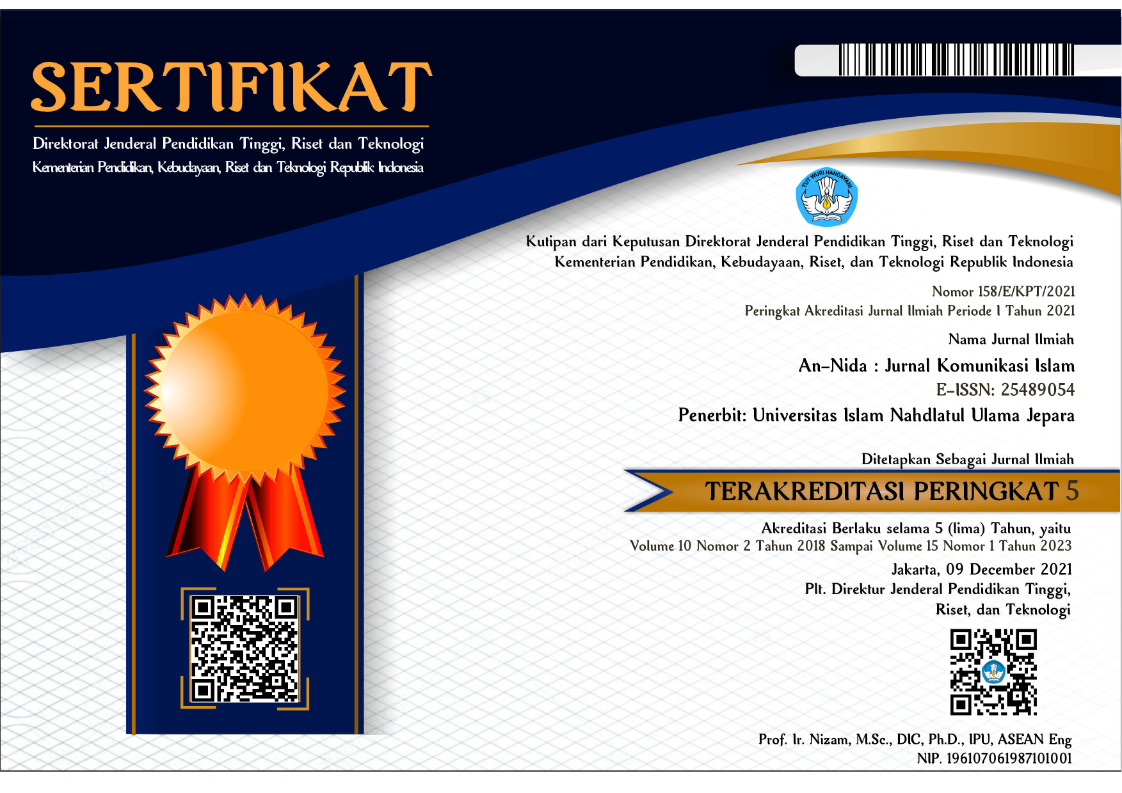MOTIF PENGGUNAAN FITUR EMOTICON DI MEDIA SOSIAL WHATSAPP: Studi terhadap Mahasiswa Program Studi Komunikasi dan Penyiaran Islam IAIN Madura
Abstract
Keywords
Full Text:
PDFReferences
Bohang, Fatimah Kartini. (2018). Pengguna Aktif Bulanan WhatsApp Tembus 1,5 Miliar at: https://tekno.kompas.com/read/2018/02/01/09270377/pengguna-aktif-bulanan-whatsapp-tembus-15-miliar.. Diunduh pada 15 Januari 2021.
Ghufron, M. Nur dan Rini Risnawita S. 2012. Teori-Teori Psikologi. Jogjakarta: Ar-Ruzz Media.
Haryanto, Agus Tri. (2019). Riset Januari 2019: WhatsApp Digilai Netizen Indonesia at: https://inet.detik.com/cyberlife/d-4461246/riset-januari-2019-whatsapp-digilai-netizen-indonesia. Diunduh pada 16 januari 2021.
Justisiani, Eka Indah. (2014). Persepsi Masyarakat Tentang Bentuk Komunikasi Verbal dan Komunikasi Nonverbal Pada Pelayanan Rumah Sakit Umum Daerah Abdul Wahab Sjahranie Samarinda, Jurnal Ilmu Komunikasi, 2(3).
Kriyantono, Rachmat. 2009. Teknik Praktis Riset Komunikasi. Jakarta: Kencana Prenada Media Group.
M Hardjana, Agus. 2003. Komunikasi Intrapersonal & Interpersonal. Yogyakarta: Kanisius.
Mulyana, Deddy. 2015. Ilmu Komunikasi Suatu Pengantar. Bandung: PT.Remaja Rosdakarya.
Nasrullah, Rulli. 2016. Media Sosial: Perspektif Komunikasi, Budaya, dan Sosioteknologi. Bandung: Simbiosa Rekatama Media.
Nugraha, Nuning. (2014). Efektifitas Komunikasi Verbal dan Nonverbal Oleh Polisi Resor Kota Samarinda dalam Mensosialisasikan Program Safety Riding Kepada Pengendara Roda Dua di Sekolah Menengah Atas Negeri 1 Negeri Samarinda, Jurnal Ilmu Komunikasi, 44.
Perdana, Aji Aditra dan Irwansyah. (2019). Model Interaksi Multikultural dalam Ruang Virtual Whatsapp: Silaturahmi, Konflik, Leave Group. ASPIKOM, 3(6).
Rakhmat, Jalaluddin. 2005. Psikologi Komunikasi. Bandung: PT Remaja Rosdakarya.
Sarwono, Sarlito Wirawan. 2002. Psikologi Sosial. Jakarta: Balai Pustaka.
Sobur, Alex. 2003. Psikologi Umum. Bandung: Pustaka Setia.
Sunu D, Aloysius. (2019). Emoji, Emoticon, dan Stiker Apa Sih Bedanya at: https://wartakota.tribunnews.com/2019/02/25/emoji-emoticon-dan-stiker-apa-sih-bedanya. Diunduh pada 20 Februari 2021.
Tri Indah Kusumawati. (2015). Komunikasi Verbal dan Non Verbal, Al-Irsyad: Jurnal Pendidikan dan Konseling, 6(2), 90.
DOI: https://doi.org/10.34001/an-nida.v13i2.2373
Article Metrics

This work is licensed under a Creative Commons Attribution-ShareAlike 4.0 International License.
| Editorial Office An-Nida : Jurnal Komunikasi Islam Fakultas Dakwah dan Komunikasi Universitas Islam Nahdlatul Ulama (UNISNU) Jepara
|














